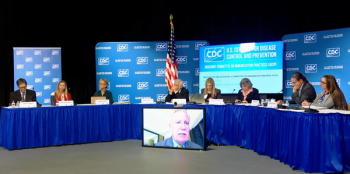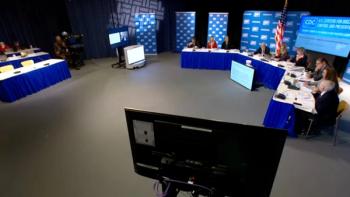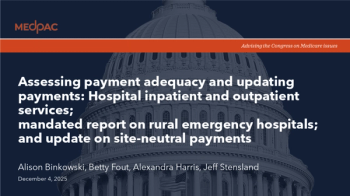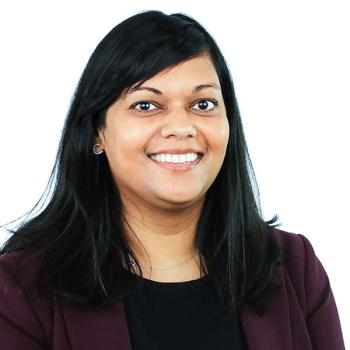
Physicians Taking Back Medicine: Keith Smith, M.D., and the free market revolution in surgery
Tired of watching patients crushed by opaque hospital billing, Keith Smith, M.D., built a free-market surgery center where transparency, affordability and physician autonomy come first.
When patients walk through the doors of the
At the heart of this revolution is
I had the privilege of speaking with Smith for the Medical Economics podcast Physicians Taking Back Medicine. For me, the conversation was not only professionally inspiring but also deeply personal. As a family physician, I’ve referred my own patients across the country to Oklahoma for surgeries they could not afford locally.
That kind of story raises the obvious question: Why isn’t this model being replicated everywhere?
From disillusionment to innovation
Smith began his practice in 1990, specializing in cardiac and pediatric anesthesia. But it wasn’t long until he began to notice the impact of third-party payers on patient care, including unpredictable and arbitrary Medicare and insurance payments.
At the same time, Smith observed hospitals slashing staff and supplies while charging patients top-dollar prices and began to feel complicit in what he described as “a financial crime” — participating in a system that exploited vulnerable patients. He gathered several trusted surgeon colleagues to forge a new model: a physician-owned, cash-based facility where patients could receive excellent care at fair prices.
In 1997, the Surgery Center of Oklahoma opened its doors.
How the model works
The Surgery Center of Oklahoma operates outside the third-party payer system. Instead of submitting claims to insurance companies or government programs, the center offers all-inclusive cash pricing. For example, a breast biopsy costs $1,900, compared with $19,000 at a nearby hospital. A laparoscopic gallbladder removal? $6,836, all in, versus up to $20,000 elsewhere.
Patients can search the surgery center’s website to see transparent prices for all surgeries offered. Rather than receiving individual bills from different surgeons and anesthesiologists, patients receive all-in-one pricing, making payment easier and more transparent. The surgery center then coordinates payments to medical team members.
The simplicity and affordability have attracted a wide range of patients, including uninsured individuals priced out of hospital-based care; patients with high-deductible insurance plans seeking predictable costs; members of self-funded employer plans or cost-sharing ministries; international patients, particularly from Canada, where coverage exists but access is limited; and patients who want to choose their surgeon and anesthesiologist based on quality outcomes. In fact, Smith said that more than 40% of the center’s patients come from outside Oklahoma, making it a destination for medical tourism.
Fighting the headwinds
The Surgery Center’s disruptive model has not been welcomed by the health care establishment. Hospitals, insurers, and even state regulators have tried to undermine the center through legal, financial, and bureaucratic attacks. But every challenge backfired.
Rather than appearing radical, the center gained a reputation as an underdog championing patients. Media coverage — including an
Yet Smith cautions that the road is not easy. “There are a lot of headwinds, and the mainstream in the industry aren’t going to take it lying down,” he says. “If you try this, you must be ready for them to play dirty.”
Why aren’t more physicians doing this?
Why? Smith believes it comes down to fear, inertia, and economics. He says that while physicians may be excellent clinicians, many are not natural entrepreneurs. Further, stepping into a free-market environment means owning your outcomes: “Patients aren’t coming to you just because you’re on their insurance panel. You have to be confident saying, ‘This is what I do, this is my price, and I’m as good as anyone.’”
Others struggle with logistics. How do you handle payments when multiple parties are involved — surgeon, anesthesiologist, facility, pathology? To solve this, Smith created Atlas Billing Company, a clearinghouse that collects a single payment from patients and distributes it to the appropriate clinicians. He even lends this system to other physicians as “training wheels” until they can manage payments independently.
Finally, Smith says that many physicians don’t fully understand free-market principles, including the importance of how patients value medical care. “Most physicians I know think they should be paid well because they worked so hard and went to school for so long and have expertise in an area,” he said, associating this line of thinking with the labor model of economics. Instead, Smith encourages physicians to consider medical economics through the lens of value, as described by the
Replicating the model
Some centers have already followed Oklahoma’s lead, such as
For physicians interested in adopting this model, Smith offers practical advice:
- Start small. Consider renting unused operating room space from a plastic surgeon nearing retirement or seek out a surgical center in decline.
- Form alliances. Collaboration among surgeons and anesthesiologists is crucial. “An anesthesiologist-led venture works best,” Smith notes, since anesthesiologists are consistently present in the OR and can oversee daily operations.
- Consider a hybrid model. Consider taking insurance until your practice grows to become self-sustaining, although Smith advises physicians to consider opting out of Medicare as soon as possible. “Get as independent as you can, as fast as you can,” he says, adding, “the very first thing I’d
walk away from is Medicare payments .” - Be realistic. Some states are hostile to physician entrepreneurship, with regulatory and insurer dominance creating “deserts” for free-market medicine. Relocation may be necessary.
- Join networks. The
Free Market Medical Association , co-founded by Smith, offers mentorship, resources, and community for like-minded physicians at every stage of the journey.
A Return to old-school medicine
Smith is quick to point out that his model isn’t new or revolutionary — it’s a return to the way medicine used to be practiced before government and corporate interference. Physicians once looked patients in the eye, quoted a fair price, and stood by it.
“It’s a mutually beneficial exchange,” he says. “Patients know exactly what they’re getting and what they’re paying. There’s none of the burnout, moral injury, or financial gamesmanship that plague traditional health care. It’s liberating.”
The atmosphere at the Surgery Center reflects this. Staff and physicians genuinely enjoy their work. Smiles replace frustration. Burnout is replaced by purpose.
Looking ahead
The Surgery Center of Oklahoma stands as proof that physicians can take back medicine — if they are willing to challenge the status quo. By prioritizing patients, embracing transparency, and trusting the free market, Smith and his colleagues have created a model that is saving lives, saving money, and restoring joy to the practice of medicine.
For burned-out physicians searching for a way out of a broken system, Smith’s message is one of hope: “There is another way. It’s not easy, but it’s worth it. And once you experience it, you’ll never look back.”
Music Credits
Medical Education by Art Media -
Editor's note: Episode timestamps and transcript produced using AI tools.
Patient Frustrations and Introduction to Keith Smith, M.D. (00:00:14) Overview of patient struggles with the healthcare system and introduction to Keith Smith, M.D., and the Surgery Center of Oklahoma.
Smith’s Background and Motivation (00:00:54) Smith's early career, government payment frustrations, and decision to leave traditional hospital practice.
Founding the Surgery Center of Oklahoma (00:01:40) How Smith built his reputation, gathered colleagues, and started the surgery center to protect patients financially and medically.
Early 90s Healthcare Problems and Free Market Motivation (00:02:27) Declining quality of care, financial abuse by hospitals, and the decision to create a fair, market-driven alternative.
All-Inclusive Cash Pricing Model (00:04:02) Explanation of the center’s cash pricing, initial patient stories, and dramatic cost differences compared to hospitals.
Building the Price List and Industry Pushback (00:05:27) Development of a public price list, industry backlash, and the center’s role as a champion for affordable care.
Posting Prices Online and Market Impact (00:06:35) Decision to post prices online in 2009, attracting patients nationwide, and sparking a price war in healthcare.
Growth and Influence of the Surgery Center (00:07:42) Expansion to a larger facility, multi-specialty services, and inspiring other centers to adopt transparent pricing.
Patient Success Story and Website Usability (00:08:39) A patient’s experience using the website, cost savings, and positive outcomes compared to traditional hospitals.
Surgeon Compensation and Hospital Billing Disparities (00:09:55) Discussion of the vast difference between hospital charges and actual surgeon payments.
Market Creation and Price Matching (00:10:09) How public pricing led to market competition, price matching by hospitals, and the creation of a healthcare marketplace.
Eliminating Middlemen and Keeping Prices Low (00:12:19) How removing hospital profit motives keeps surgery prices reasonable and benefits both patients and physicians.
Barriers for Surgeons Adopting the Model (00:12:38) Challenges and fears preventing more surgeons from leaving the traditional system for a free market approach.
Entrepreneurship and Payment Systems for Physicians (00:13:11) The need for confidence, entrepreneurship, and understanding payment logistics for physicians considering this model.
Atlas Billing Company and Free Market Medical Association (00:14:32) How Smith’s billing company and association help other physicians transition to cash-based or hybrid models.
Headwinds and Examples of Success (00:15:46) Real obstacles, government resistance, and examples of other centers successfully adopting the model.
Advice for Physicians Considering the Model (00:18:23) Practical steps for doctors: starting small, finding leadership, and considering relocation to more receptive areas.
Overcoming Inertia and Finding Opportunities (00:20:29) Discussion of geographic and systemic barriers, and strategies for launching a physician-owned center.
Risks of Insurance Contracts and Going Independent (00:22:14) Risks of working with insurance companies, benefits of independence, and advice to leave government payments.
Economic Principles and Physician Value (00:23:44) Understanding value from an economic perspective and the importance of seeing value through the patient’s eyes.
The Free Market Model as a Positive Alternative (00:25:03) The benefits of the free market approach for physicians and patients, and encouragement to explore the model.
Closing Remarks (00:25:54) Host’s closing comments and invitation to future episodes.
Newsletter
Stay informed and empowered with Medical Economics enewsletter, delivering expert insights, financial strategies, practice management tips and technology trends — tailored for today’s physicians.















